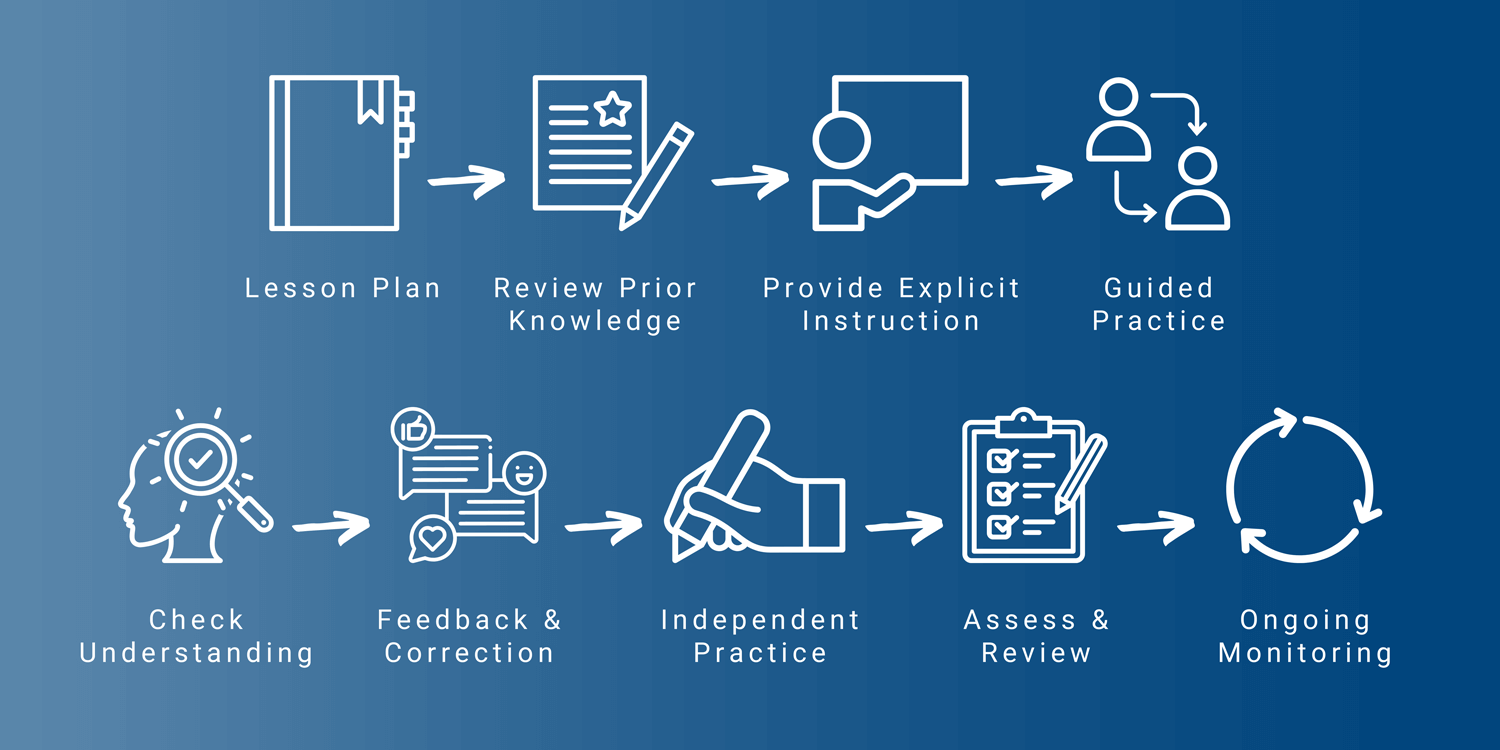As the name implies, direct instruction involves educators teaching through clear, straightforward, and explicit directions. The direct instruction model is teacher-led, clearly presenting students with the necessary information or detailing steps in a process before opportunities for guided and independent practice arise. Effective direct instruction imparts new, foundational knowledge and essential skills to build upon with future lessons. This guide overviews the direct instruction method, its benefits, possibilities, examples of direct instruction strategies, and more.
What Is Direct Instruction in Education?
Dr. Siegfried Engelmann began developing the direct instruction teaching model in the early 1960s. Working in advertising, he was curious about how different techniques could influence a child’s ability to absorb, retain, and recall new information. Engelmann insisted that all children can be taught. “The intellectual crippling of children is caused overwhelmingly by faulty instruction—not by faulty children,” Engelmann wrote.
He began filming teaching sessions with his sons to demonstrate the effectiveness of his theories and techniques; then, he began working with educator and researcher Carl Bereiter at the University of Illinois. The two founded the Engelmann-Bereiter Preschool to implement their philosophy. They started publishing books and materials on their successes in teaching disadvantaged young children, helping them catch up to and surpass their peers.
The National Institute for Direct Instruction (NIFDI) was founded in 1997 with Engelmann as its director. According to NIFDI, direct instruction is a teaching model “that emphasizes well-developed and carefully planned lessons designed around small learning increments and clearly defined and prescribed teaching tasks.”
Key characteristics of direct instruction include:
- Teacher-Led Instruction: The teacher takes an active role in delivering instruction, providing explanations, demonstrations, and guiding students throughout the lesson.
- Explicit and Clear Instruction: Direct instruction focuses on clearly and explicitly teaching skills and concepts, breaking them down into manageable parts, and providing specific examples and explanations.
- Active Student Engagement: Students actively engage in learning through frequent opportunities to respond, practice, and receive feedback. Active student engagement can involve whole-group instruction, small-group work, or individual practice.
- Mastery and Pacing: Direct instruction emphasizes content mastery before moving on to new material. Lessons are typically paced to ensure that all students have a solid understanding of the content before progressing.
- Continuous Assessment: Regular assessments monitor student progress and deliver feedback. Ongoing assessment allows teachers to adjust instruction and provide additional support or enrichment.
How Is Direct Instruction Used in the Classroom?
Here are some key steps involved in implementing direct instruction:
- Build a lesson plan. You carefully plan the lesson, breaking down the content into smaller, manageable parts and determining the instructional sequence. Establish clear learning objectives to guide the instruction.
- Review students’ prior knowledge. Assessing which skills students have mastered and which they still need to learn helps activate students’ existing knowledge and create connections to new learning. Use a KWL (Know/Want to Know/Learned) chart to activate prior knowledge. Have students list what they already know about the topic in the “K” column. This helps you understand their starting point and provides a foundation for building new knowledge.
- Provide explicit instruction. Deliver clear and direct instruction to introduce new concepts, skills, or content. Provide explanations, demonstrate procedures, and use visual aids or multimedia resources to enhance understanding.
- Give guided practice. After the initial instruction, guide students through structured practice activities. Guided practice can involve modeling examples, leading students through step-by-step exercises, or facilitating group work.
- Check for understanding. Continuously check for understanding throughout the lesson to assess student progress. You can accomplish this through questioning, informal assessments, or formative assessments to gauge comprehension and identify areas of difficulty.
- Feedback and correction. Provide immediate feedback and correction to students, helping them understand any errors or misconceptions. Ask questions to gauge students’ understanding and reiterate specific points as needed while they practice what they’ve learned independently. You can provide modified group instructions to accommodate varying learning rates, and students can progress to more advanced material as they develop skills and gain knowledge.
- Allow for independent practice. Once students have demonstrated understanding through guided practice, have them engage in independent practice to reinforce and apply the newly learned skills or knowledge. Have them complete worksheets, participate in activities, or solve problems independently.
- Assess and review. Whether evaluations come through issued quizzes and tests, exit tickets, or larger ongoing projects, use formative assessments to ensure students know everything they need before moving on to new concepts that build upon their learning. Based on the assessment results, identify areas that require further review or provide additional enrichment activities.
- Conduct ongoing monitoring. Throughout the instructional process, monitor student progress and adjust instruction as needed. You may need to provide additional support, re-teach certain concepts, or provide extension activities for students who have mastered the content.
Be mindful and introduce new concepts in smaller, sequential chunks gradually. Give explicit, step-by-step directions and guidance as students begin practicing the new skills or concepts collectively.

What Are Advantages of Direct Instruction?
Decades of research, studies, and comprehensive meta-analysis continue to affirm and find highly positive results on the effectiveness of direct instruction in classrooms with children of all ages and cultural or socioeconomic backgrounds.
Project Follow Through, a nearly 10-year education experiment sponsored by the federal government beginning in the late 1960s, was the first and most extensive study of its kind. Tasked with determining the best ways to teach at-risk children in kindergarten through lower elementary grades, it compared 22 teaching models across 178 communities and more than 200,000 students. The experiment results revealed that students who received direct instruction had significantly higher academic achievement than those in the other programs.
Decades of additional research and meta-analyses of hundreds of other studies since have replicated Project Follow Through’s findings showing that those students who receive direct instruction:
- Excel academically
- Outperform their peers in reading, spelling, and mathematics
- Become more likely to graduate high school and pursue higher education
Many styles and manners of teaching have their merits and can benefit students. While teacher-directed learning has pros and cons, and student-directed techniques have gained popularity for spurring engagement, teacher-directed instruction remains a common foundational cornerstone in helping teach children the best practices and processes for learning.
It’s a common misconception that direct instruction only involves teachers delivering a scripted lecture from the front of the class while students sit silently and take notes. The reality is that, when applied correctly, direct instruction provides opportunities for varied teaching tailored to groups of students’ different ability levels and paces of learning.
In addition to being a powerful teaching technique, direct instruction can also help teachers build relationships with students during lessons that encourage dialogue and communication in the classroom. While the guided, scripted nature of many traditional direct instruction lessons may seem restrictive, the processes for guided practice, gathering feedback, and conducting real-time assessments produce many opportunities for students to share ideas with peers and communicate with teachers.
What Are the Best Subjects for Direct Instruction?
Direct instruction is best utilized when content is new in any subject, more specifically when it includes declarative or procedural knowledge. Declarative knowledge refers to knowledge about facts, concepts, principles, or rules. It involves understanding “what” or “that” something is, and declarative knowledge is typically focused on the acquisition of information and can be stated in a propositional form.
Knowing the capital of a country or understanding the concepts of lines, shapes, color, texture, and space in art are examples of declarative knowledge.
Procedural knowledge refers to knowledge about how to perform a task or a skill. It involves understanding “how” to do something and is often related to step-by-step procedures, strategies, or techniques required to accomplish a specific task. Knowing how to write and construct a persuasive essay, how to solve a long division problem, or how to play a musical instrument are examples involving procedural knowledge.
In the context of direct instruction, both declarative and procedural knowledge can be effectively taught through explicit, structured, and teacher-led instruction. The teacher provides clear explanations, demonstrations, and examples to ensure that students understand the facts, concepts, principles (declarative knowledge), as well as the steps, procedures, or strategies (procedural knowledge) necessary to achieve the learning goals.
The goal is to make the information or skills explicit and accessible to students, allowing them to grasp the content more effectively. Since every subject will encounter both types of knowledge at some point in their learning progression, direct instruction can be used by every teacher.
There are some skill-based subjects that might use or benefit from direct instruction more often than others, including the following examples:
Mathematics
From the earliest addition and subtraction problems through advanced algebra and beyond, direct instruction can help students comprehend concepts and systematically solve equations at every level of math class.
Many areas of mathematics require following specific procedures, processes, orders of operations, or algorithms. Guide students through each point of the long division process, clearly demonstrate the methods for graphing and interpreting statistical data, or efficiently and effectively explain each step in the formulas for calculating geometric angles and measurements.
Math lends itself to the teaching style as a subject as many math class lessons include the “teach, practice, get feedback, reinforce, repeat” process that is effective with most math. For example, math lessons often follow this direct instruction sequence:
- The teacher introduces a new type of equation or formula to students, demonstrating the methods for solving and guiding the class through a diverse handful of example problems.
- The teacher gradually releases responsibilities to students, who collectively make their way through a few equations as a class. Alternatively, students may work alone or in small groups as the teacher walks around the room, checking in, answering questions, and observing for opportunities to offer advice or to re-teach a step.
- Students can practice similar problems independently or complete assigned homework on the concept.
Science
Science experiments are, by name, experimental, but as a teaching tool, they’re a well-proven demonstration element within direct instruction lessons. Chemical reactions and the periodic table can be effectively taught through direct instruction, as can concepts throughout chemistry, biology, physics, and more.
Science classes often involve complex concepts, abstract ideas, or theoretical subjects. Direct instruction helps students understand scientific principles and processes by breaking down concepts into understandable parts. The procedural knowledge and step-by-step guidance required for experiments or science projects are effectively taught through direct instruction, which can also convey relevant vocabulary or terminology, develop students’ inquiry skills, and reiterate safe laboratory procedures.
Language Arts
With younger students and relatively inexperienced learners, direct instruction is an effective approach for teaching phonetic concepts, reading comprehension skills, and basic vocabulary development. Clearly explaining reading or language concepts is essential in establishing students’ foundational literacy skills.
Writing may be perceived as more “art” than “science,” but there are step-by-step processes to crafting a persuasive essay or writing a three-act arc, for example. Allow for independent practice. Direct instruction English lessons can include teachers demonstrating specific reading strategies, writing processes, or language conventions to model how effective readers, writers, and communicators apply their knowledge.
Best Subjects for
Direct Instruction
![]()
Mathematics
![]()
Science
![]()
Language Arts
Key Tips for Implementing Direct Instruction Strategies
The misconception that direct instruction is only for lecture-style lessons carries with it the untrue (and unfair) assumption that direct instruction is a boring, rote, and uninspired exercise in learning.
Direct instruction teaching shouldn’t be a one-way street of information delivery void of engagement, meaningful interactions, or constructive back-and-forth with students.
Yes, direct instruction relies on teachers clearly and explicitly presenting information or step-by-step instructions. However, many ways exist to accomplish an engaging presentation for students. Methods can vary, from a traditional oral presentation backed by a slideshow to educational videos, hands-on props, or other fun visual aids.
Consider trying out some of the following tips as part of your next direct instruction lesson plan:
- Consider effective ways you can engage as many various types of learners as possible.
- Utilize graphic organizers such as a concept web, mind map, or Venn diagram to begin students’ guided practice by creatively displaying key ideas behind the subject matter.
- Develop a system for quickly and efficiently touching base with every student during their guided practice, even if you can’t stop and engage in a conversation with each one. Scan for signs of understanding, make eye contact or have students hand in their guided practice questions so you can ensure they’re following and comprehending what you’re teaching.
- Design assessments or quizzes with gamified elements, such as leaderboards, badges, or levels. This transforms the assessment process into a more engaging and competitive experience for students.
DI Spotlight: Supporting Students with Learning Disabilities
While first developed to help disadvantaged or “at-risk” students catch up to (and surpass) their peers at a young age, research shows the direct instruction curriculum benefits learners at every grade level and across geographic settings, racial and ethnic populations, and socioeconomic backgrounds, as well as students experiencing learning difficulties or differences.
According to the National Center for Learning Disabilities (NCLD), one in five American students face learning and attention difficulties such as dyslexia and other learning disabilities, ADHD, or related disorders. In a teacher survey, the organization found just 17% feel very well prepared to teach students with mild to moderate learning disabilities.
The NCLD identifies explicit and targeted direct instruction as one of the top practices that educators may implement to improve academic achievements among students with learning disabilities.
Through step-by-step modeling, thinking out loud during problem solving, and guided as well as independent practice, explicit direct instruction makes the learning process overtly clear and somewhat systematic. Direct instruction reduces the cognitive demand placed on students and lets them focus on mastering clearly defined expectations.
Based on an extensive literature review of empirical studies, the NCLD’s “Forward Together” report identifies three critical mindsets educators must adopt to have a positive influence on development of students affected by learning and attention issues:
- A strong sense of self-efficacy. When teachers strongly believe in their abilities to teach all students successfully, they’re more likely to take the additional steps and practice the strategies that help all students reach academic achievements.
- A personal responsibility for including and reaching all students. Teachers with a positive attitude toward inclusivity and who feel personally responsible for their students’ learning are more likely to believe that students with disabilities can be successful. This belief encourages more educators to differentiate teaching methods and try other approaches such as direct instruction.
- A growth mindset. As all students can learn through hard work and practice, teachers must recognize they can improve as educational professionals rising to new and evolving challenges. Educators with a positive growth mindset recognize that learning disabilities, ADHD, and other related disorders won’t disappear over time. However, the right strategies, development, and support can help affected students achieve grade-level standards on par with their peers.

Discover More Direct Instruction Strategies and Activities with Avanti
Direct instruction is an effective teaching method for educators of all types of students at any grade and ability level. While many teachers are familiar with the basics and high-level principles of the philosophy, Avanti offers some new, specific, and proven strategies for quickly implementing direct instruction tactics into your lessons.
Teaching strategies, philosophies, and techniques (like direct instruction) are thoroughly analyzed, constantly refined, adjusted, and revamped with new data and feedback. Shouldn’t teachers’ professional development be approached the same way?
Avanti is a new approach and fresh face for professional development that gives educators autonomy to blaze their own trail learning easy-to-implement strategies relevant to their unique classrooms and challenges. Avanti supplements and supports the PD you already do, offering hundreds of brief videos and various resources for growing on your own schedule.
Direct instruction is a core content pillar in the vast Avanti resource library where subscribers can filter videos and accompanying downloads by topic and grade level audience. More highlights of an affordable Avanti membership include:
- An easy-to-use online platform, accessible 24/7 from any internet-connected device
- Hundreds of brief, on-demand, research- and experience-based videos
- Implementation guides, reflection rubrics, or other downloadable resources with each video lesson
- A collaborative community forum for asking questions, trading tips, and sharing success stories
- Regularly scheduled livestream discussions and speaker series
- Teacher training time may apply toward continuing education credits for teaching licensing requirements (Note: Confirm with your local district office)


